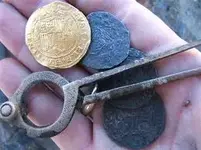Blindbowman
Bronze Member
- Joined
- Aug 15, 2007
- Messages
- 2,068
- Reaction score
- 1,005
- Golden Thread
- 0
- Primary Interest:
- All Treasure Hunting
here i will help you once ... you see this old set of dividers .. thats the type of tool that made the drawings on the stones ,, ya portuguese captains had them .. ........ 







